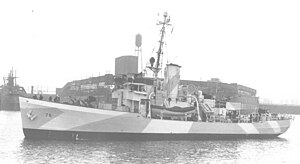USCGC Comanche (WPG-76)

USCGC Comanche (WPG-76)
|
|
| History | |
|---|---|
|
|
|
| Name: | Comanche |
| Namesake: | The Comanche Native American tribe |
| Builder: | Pusey & Jones Corporation, Wilmington, DE |
| Cost: | $525,550 |
| Laid down: | 14 October 1933 |
| Launched: | 6 September 1934 |
| Commissioned: | 1 December 1934 |
| Decommissioned: | 29 July 1947 |
| Fate: | Sold, 10 November 1948 |
| General characteristics | |
| Displacement: | 1,005 tons |
| Length: | 165 ft (50 m) |
| Beam: | 36 ft (11 m) |
| Draft: | 12 ft 3 in (3.73 m) mean |
| Propulsion: |
|
| Speed: |
|
| Range: |
|
| Complement: | 6 officers, 56 men (1934) |
| Sensors and processing systems: |
|
| Armament: |
|
The United States Coast Guard Cutter Comanche (WPG-76) was built by Pusey & Jones Corporation, Wilmington, Delaware, and launched 6 September 1934. She was commissioned on 1 December 1934. She was used extensively during World War II for convoy operations to Greenland and as a part of the Greenland Patrol.
The cruising cutter Comanche, was the fifth of six "165 foot(A)-class" cutters that were constructed based on a 1915 Tallapoosa/Ossipee design that included provisions for light ice-breaking and the first class that utilized geared turbine engines. Comanche was capable of breaking up to 2 foot of ice because of a reinforced belt at the waterline. Built by Pusey & Jones Corporation of Wilmington, Delaware, Comanche was commissioned on 1 December 1934 and was originally stationed at Stapleton, New York, which remained her homeport until 1940. She carried out the standard missions of the Coast Guard at that time, including law enforcement, search and rescue, and light ice-breaking on the Hudson River.
Comanche made history in 1940 when she transported the first American Consul to Ivigtut, Greenland, on the invitation of the Danish government-in-exile, beginning a close association between Greenland and the Coast Guard during the war. On 1 June 1941 she was assigned to the newly established South Greenland Patrol and was transferred to the Navy on 1 July 1941 where she operated under the control of CINCLANT (DESLANT) [Commander in Chief, Atlantic Fleet, Destroyer Command, Atlantic] and her homeport became Boston. She was used primarily for convoy escort to Greenland waters.
On 27 March 1942 Comanche left Boston escorting Lightship No. 110 to Portland, Maine. There she engaged in anti-submarine exercises and on the 29th got underway with the Frederick Lee, escorting lightship No. 110 and the SS Omaha to Argentia, arriving there 4 April 1942. Next day she was escorting Omaha to Greenland, anchoring at Bluie West One. On the 15th she departed for Ivigtut. She remained there until the 28th when she then transported and assisted a survey party of Army personnel in the preliminary survey and selection of a tank-farm site at Ivigtut, also construction site "C" at Kajartalik. She returned to Bluie West One on 28 April and remained there until 8 May 1942. While there details were arranged for the flight of six PBY's from Argentia to Iceland via Bluie West One, the Comanche taking communication guard of planes in the flight. On 8 May she proceeded to Ivigtut to guard the cryolite mines there, remaining until 20 May 1942.
...
Wikipedia
